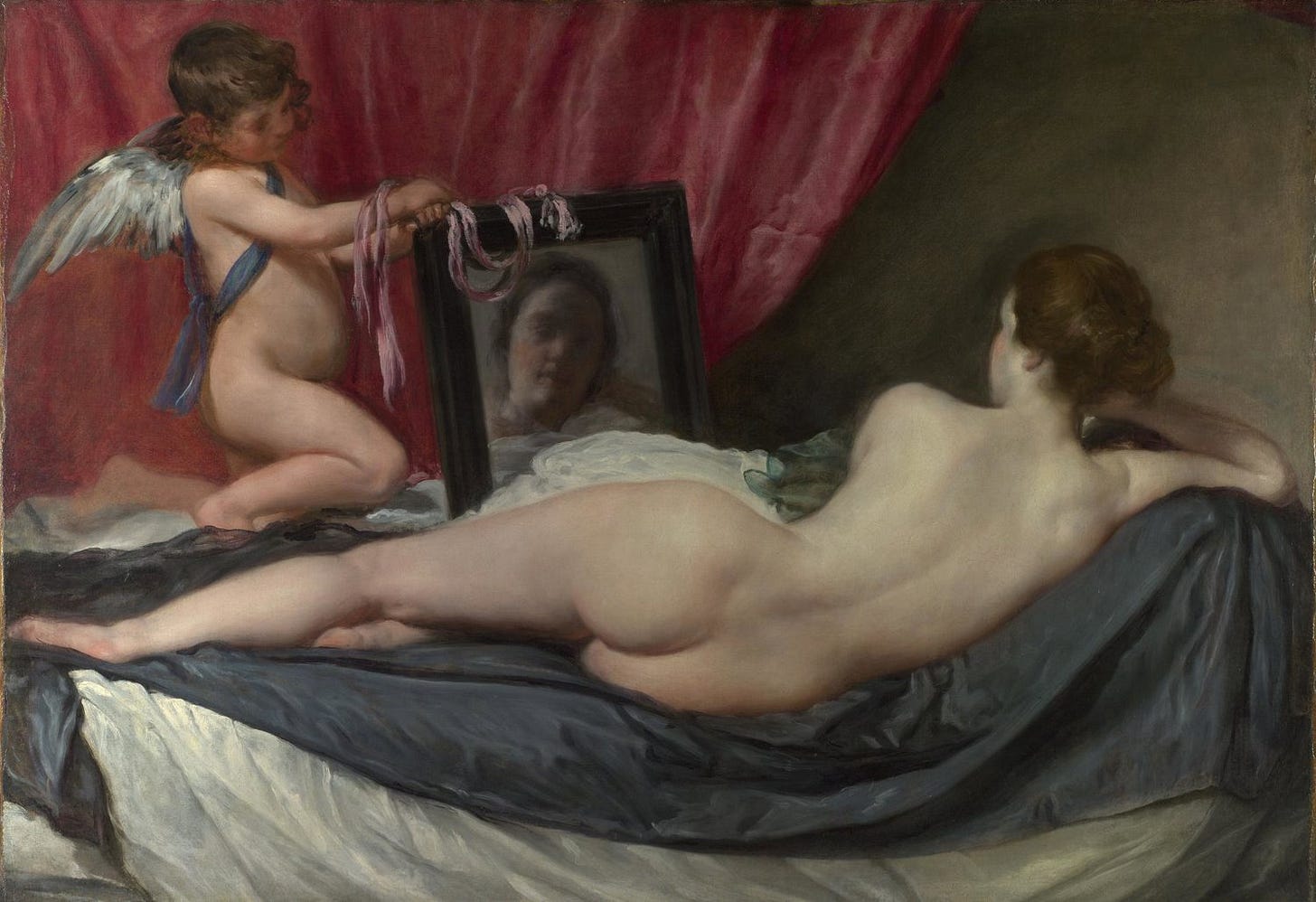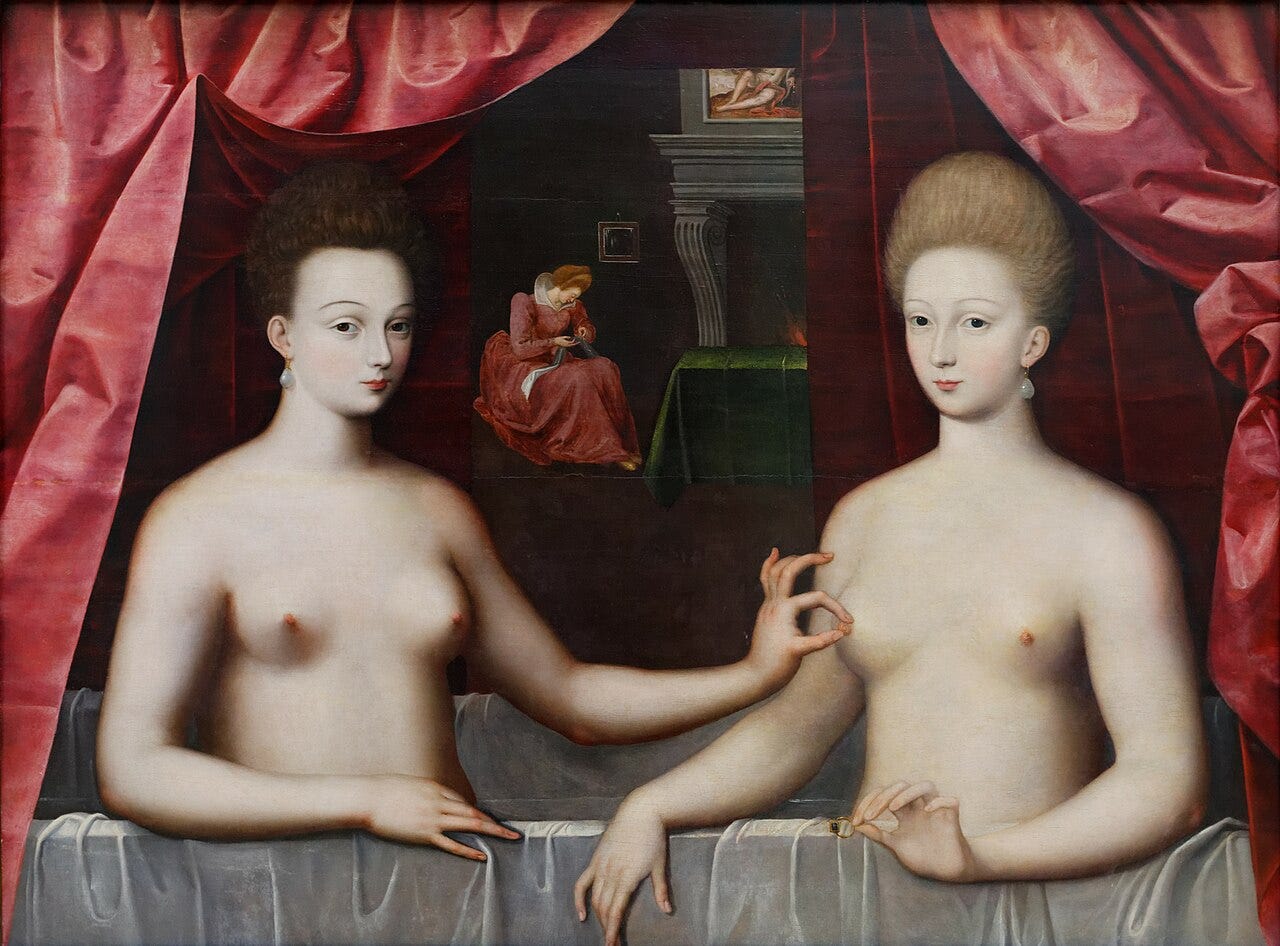European Nudes: Artistic Expression or Objectification?
Picture classical European art. What do you see? Likely, it’s the image of a graceful, painted nude—often a serene, statuesque figure reclining elegantly on a luxurious sofa. This portrayal of the idealized female form has become emblematic of Western art’s highest achievements.
That being said, there may be another truth lurking behind this genre.
What if painted nudes, far from being purely aesthetic masterpieces, were created with a deeper, more troubling motive? What is certain is that these images were not created in a vacuum: they were shaped by the social structures and power dynamics of their time. I would go as far as to argue that these images reflect the ways in which women have been historically objectified by male patrons and artists alike.
Living for the Male Gaze
To understand how nudes exist for the male gaze, we must address the following question: what exactly is objectification?
Simply put, women are objectified when they are solely defined by their physical appearance or sex appeal, and reduced to nothing more than something to be looked at, touched, or admired—rather than being seen as complete and complex human beings with thoughts, emotions, and agency.
Objectification essentially presumes an indifference to who any one woman really is. In this process, women’s individuality, thoughts, and emotions are erased, leaving them as passive, one-dimensional figures meant to serve someone else's desires.
Waiting to be Seen
Classical nudes are far from neutral depictions of the female form; they were created through and for the male gaze, reinforcing the objectification of women. Often commissioned by male patrons for private viewing, these artworks allowed the female body to be admired in solitude, free from public judgment. This intimate setting amplified the male owner’s control over the image, reducing the woman to an object of desire and perpetuating the power dynamics central to the male gaze.
As John Berger explains in the third essay of Ways of Seeing (1972), "Men look at women. Women watch themselves being looked at." In this way, women come to view themselves as objects to be observed—essentially reducing themselves to mere sights.
Take Titian’s Venus of Urbino, for example. This painting shows a reclining woman gazing directly at the viewer. The way she is positioned—soft, languid, and vulnerable—invites admiration and desire. Her body is not only the focal point of the image, but also carefully constructed to appeal to male sensibilities. Her direct gaze seems to beckon the viewer to enjoy her beauty, reinforcing the idea that she solely exists for the male viewing pleasure. This positioning embodies the male gaze in art: the woman is passive, exposed, and objectified for the viewer’s admiration, while the viewer holds the power. Venus is aware of her role as an object to be seen.
Venus of Urbino, Titian (1538)
Similarly, in Diego Velázquez's The Rokeby Venus, the nude Venus lies on a divan, her back to the viewer, gazing into a mirror. Her exposed body, with its soft, sensual curves, is designed to evoke desire, but the pose and the act of looking into the mirror suggest she is not an active participant in her own story. Rather, she lays there, waiting to be gazed upon, she cannot act or engage the viewer. Interestingly, this scene not only depicts the viewer treating the woman as an object of desire, but also shows the female subject seeing herself as nothing more than a sight, as she gazes at her reflection in the mirror. The passive nature of her depiction exemplifies the way art has historically positioned women as static objects to be consumed by a male patron.
The Rokeby Venus, Diego Velázquez (1647-1651)
Nudity or Nakedness?
The male consumption of the female form in art becomes clearer when we distinguish between "nudity" and "nakedness." Nudity is a deliberate state of undress, created specifically to cater to the male gaze and invite admiration, while nakedness refers to a more natural, unidealized state, where a woman’s body is not objectified or subject to external scrutiny—she is simply naked in private. In other words, nudity is for display, while nakedness is personal and unobserved.
In Jean-Auguste-Dominique Ingres’s The Turkish Bath, the idealized female form is presented in a reclining position, with exaggerated curves meant to delight the viewer’s eyes. The women in this image are not portrayed as natural, real people but as perfectly sculpted figures solely meant to evoke beauty and desire. The figure in the foreground, in particular, is not simply naked—she is nude, carefully constructed for the viewer's pleasure, with no sense of intimacy or naturalism.
The Turkish Bath, Jean-Auguste-Dominique Ingres (1862)
In contrast, Édouard Manet’s Olympia presents a more confrontational kind of nude. The woman is directly looking at the viewer with an assertive expression, challenging the passive, idealized nudes of the past. Unlike the women in earlier works, she is not demure or shy—she is aware of her viewer, directly engaging him, thus refusing to be reduced to a simple object of male desire. Ironically, while Manet’s Olympia appears to assert some agency, she is still an object wainting to be “seen”, challenging the male gaze without but fully escaping it.
Commodities Ready for Consumption
Objectification and nudity are closely tied to commodification. The nude transcends its role as an artistic form to become a product—something to be bought, sold, and consumed. In this process, the female subject is stripped of agency and reduced to a mere spectacle, existing solely for the gaze and pleasure of others.
For instance, the painting Gabrielle d'Estrées et une de ses soeurs shows the mistress of King Henry IV of France, Gabrielle d'Estrées, in an intimate and provocative moment with her sister - perhaps satisfying some secret desire of King Henry IV. The mistress’ nudity can also be seen as a sign of submission - to the King who “owned” both woman and painting. Here, the scene blends portraiture with eroticism, emphasizing Gabrielle d’Estrées’ beauty and reinforcing the power dynamics where she exists solely to be admired and consumed by the King. Simply put, this image was only created to flatter the King.
Gabrielle d'Estrées et une de ses soeurs, Unknown Artist (1575-1599)
The commodification of the female body in European nudes is further exemplified by Ingres’s La Grande Odalisque (1814). The painting shows a woman lying on a bed, her elongated, exaggerated body a fantasy for the viewer’s eyes. The exotic setting and the luxuriously rendered details—her skin, her jewels, and the fine textures of the bed—are all designed to create a fantasy of allure and submission.
The woman’s nudity is not meant to depict any kind of natural, intimate experience but is a carefully constructed, commodified image created to match the luxury and splendor of her imagined surroundings. She is, literally, a commodity within the artwork - not too far removed from her ostentatious headwear.
La Grande Odalisque, Jean-August-Dominique Ingres (1814)
Beyond History, Into the Present
Critiques of classical art may seem like a thing of the past, but their implications remain deeply relevant today. The power dynamics that shaped the portrayal of women in European nudes continue to influence how women are represented in contemporary media, advertising, and popular culture.
In magazines, films, and on social media, women are often depicted as passive objects of desire, reinforcing outdated stereotypes about beauty and value. In the music industry, female artists are pressured to "show some skin" and adopt hyper-sexualized personas, with their talent overshadowed by their appearance. On Instagram, influencers edit their images to conform to unrealistic beauty standards. Even on magazine covers, women are airbrushed and slimmed down, sending the message that a woman’s worth is defined by her looks. This pressure to conform to an idealized version of beauty reduces women to visual commodities, reinforcing the idea that women solely exist for others to gaze upon.
Understanding how women were portrayed in classical nudes helps us recognize how these power dynamics have shaped not just art, but the broader societal treatment of women.
The next time you encounter a classical nude—whether it’s Titian's Venus of Urbino, Velázquez's The Rokeby Venus, or Ingres's La Grande Odalisque—consider the layers beneath the surface. These paintings aren’t just depictions of beauty; they are products of a system that objectified the female form, a legacy that still shapes how women are seen (and unseen) today.







